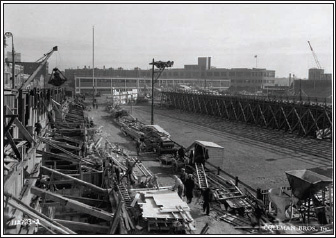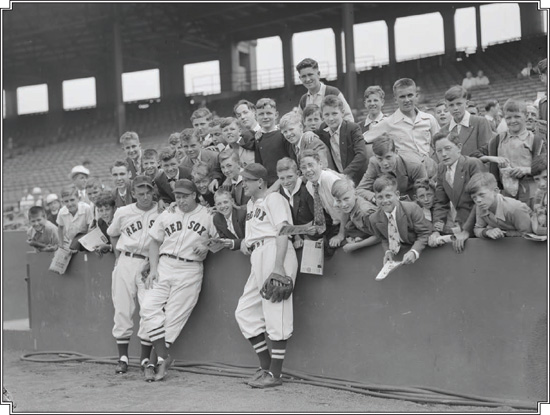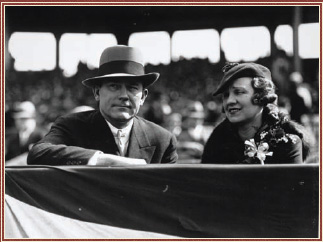Fenway Park (16 page)
Authors: John Powers


A fire during renovations on January 5, 1934, destroyed much of the ballpark seen in this vintage postcard, though the original facade endures. The workforce was bolstered and repairs and improvements that included replacing wooden grandstands with steel and concrete were completed in time for the 1934 season.
Grove, who’d won 172 games over the previous seven years, ended up going 8-8 and Mack, the Philadelphia owner, felt so badly that he offered to give Boston back its money. But Yawkey was in for the long term. Grove pitched another seven seasons in Boston, won nearly 100 more games and made the Hall of Fame.
The franchise clearly was on the rise and its new owner had no problem opening his overflowing wallet to fuel the ascent. But Yawkey’s $250,000 bid for Senators shortstop Joe Cronin, twice what the Yankees had paid for Babe Ruth, was so extravagant that even Washington owner Clark Griffith couldn’t believe he was serious. “Take it or leave it,” Yawkey told him to his face. “I’ll not be back.”
Trading the man who’d just married Griffith’s adopted daughter wasn’t a bad way of shedding a son-in-law, one wag observed. And Cronin, who’d led the Senators to the pennant two years earlier as player-manager, was delighted to go to Boston in the same role. “A fellow with an Irish name like mine ought to get along there,” he said.
The Sox were already in first place when they knocked off the Yankees in the Fenway home opener in 1935, giving rise to a rare case of spring fever in the Hub. “One hundred and forty seven more games before the World Series,” Hy Hurwitz observed in the
Globe
. While the Fall Classic would remain a pipe dream for another decade, the fans became entranced by a spirited and volatile club that could go from fifth to third to fourth place in three days and produce astonishing moments.

The massive reconstruction, directed by new owner Tom Yawkey, dramatically upgraded Fenway Park before the start of the 1934 season.
None was more bizarre than the triple play that Cronin hit into against the Indians on September 7 at Fenway, when his line drive skipped off the glove of third baseman Arvel Odell “Bad News” Hale, bounced off his forehead and into the glove of shortstop Bill Knickerbocker, who doubled up Bill Werber with a toss to second baseman Roy Hughes, whose relay to first nipped Mel Almada. “Nobody in all probability ever saw one like it,” James O’Leary wrote in the
Globe
, “and nobody is likely to see another.”
Even when the Sox were out of contention they were well worth the admission price. A record 49,000 turned up for a Sunday doubleheader with the Yankees in late September with another 10,000 refused entry. As it was, hundreds of fans stood behind a rope in the outfield where they were pelted with bottles by “bleacherites” whose view was blocked. “Boston was established beyond all doubt yesterday as the greatest baseball city in the universe,” Gerry Moore declared in the
Globe
.
Yet for as many millions as the new regime had pumped into the park and the roster, it only had brought the Sox up to mediocrity. The club won just two additional games that year and still finished fourth. So Yawkey did what he would do for the next four decades—he brought in a right-handed wallbanger, sending $150,000 and two bodies to the Athletics for brawny Jimmie Foxx, whose 58 homers in 1932 were just two shy of Ruth’s single-season mark. “Don’t be surprised to see the Ruthian record fall,” predicted the burly first baseman.
Though Double X whacked 41 homers and knocked in 143 runs, the Sox sagged badly in 1936. After sitting in first place in early May, the club went into a June swoon, going 4-13 on a 17-game road trip that was so horrific Yawkey was billed for the damage that his players did to clubhouses in Chicago and New York. In mid-July, only 2,500 witnesses turned up for an 11-3 home loss to Cleveland amid what the
Globe
termed “the unprecedented nose-dive of the most expensive collection of talent in the history of baseball.”

Boston’s boys of summer in the 1930s included (left to right) Jack Wilson, Jimmie Foxx, and Joe Cronin.
They were the “Gold Sox” and the “Millionaires” who had a perverse attraction to Skid Row. A national poll declared Boston’s sixth-place showing as the year’s biggest sports “floperoo,” far ahead of the knockout of Joe Louis by Max Schmeling and the U.S. tennis team’s defeat by Australia in the Davis Cup. Yet Yawkey insisted that he still liked his club’s chances for 1937. “People were beginning to think that nobody liked the Red Sox but their mothers,” wrote John Lardner, who dubbed their owner a “dealer in second-hand ivory.”
What Yawkey most liked was the future and, after spending seven figures on the expensive present, he now began looking to his embryonic farm system to deliver. While the Cardinals and Yankees had been growing their own talent, the Sox owner had been buying overpriced and overripe produce from his competitors. So he looked at what seedlings were available on their minor-league affiliate in San Diego and came up with 19-year-old Bobby Doerr, who started immediately at second base in 1937 as the club’s only field player under 23.
But Doerr wasn’t quite ready for prime time—he played only 55 games—and though the Sox were clearly improving, they weren’t anywhere near a match for the pinstriped champions. “You better warn the Yankees next time you see them,” Foxx had advised a visitor in spring training. But when Boston had a chance to draw within grappling distance in August after climbing from fifth place to second, New York grabbed three of four games in a turbulent pair of midweek doubleheaders at Fenway that essentially ended the season for Boston.
The first of them, played before a crowd of more than 36,000 (with another 15,000 wanna-sees turned away), consumed just under six hours and after the opener went 14 innings, the nightcap was called after seven because of darkness. “It looks like Tom Yawkey will still be among the scant few who isn’t on W.P.A.,” Hy Hurwitz observed in the
Globe
after more than 20,000 fans turned up the next day.

FIRE AND ALL, IT WENT YAWKEY’S WAY
In its first 21 years—through a series of owners and the disastrous wholesaling of Red Sox talent—Fenway Park remained virtually unchanged, except for the effects of a fire on May 8, 1926, that destroyed the wooden grandstand past third base. Those seats were not replaced for years, leaving a wide gap in foul territory that remained until the sale of the team and the ballpark to Thomas A. Yawkey on February 25, 1933.
Yawkey immediately ordered a renovation of Fenway that reports of the day estimated would cost between $750,000 and $1.25 million. Yawkey promised a new team and a new image, and instantly began investing in his two assets—though those plans were jeopardized by yet another fire.
The Osborn Engineering Co., the Cleveland-based firm that designed Fenway Park in 1911, was hired for the reconstruction, which began in the fall of 1933. Fenway was largely unchanged in the area that horseshoed behind and around home plate. However, all the areas that had originally consisted of wooden grandstands, including left field, right field, and center field, were given a concrete base—and the outfield bleachers were expanded.
But on January 5, 1934, in the middle of renovations, a heater being used to dry the concrete overturned. A nearby canvas caught fire and the new left-field grandstand went up in flames. The fire quickly spread to the center- and right-field bleachers, and then jumped Lansdowne Street and engulfed five buildings across the street. The effort to fight the five-alarm fire was hampered by dense smoke and icy footing, but none of the roughly 700 workers on site or the more than 100 firefighters was seriously hurt. Damages from the fire were estimated at $250,000.
Red Sox general manager Eddie Collins admitted, “We may have to rebuild a large part of the bleachers we had just finished,” but he was confident that the team would still open its season on time. Though the Braves offered the use of their field as a temporary home, the number of construction workers was boosted to nearly 1,000 and the work was completed on schedule. Yawkey, who was on a hunting trip in South Carolina when the fire broke out, did not cut his trip short.
The deepest region of Fenway Park, beyond the flagpole in center field, originally measured 468 feet and the right-field foul line extended 358 feet. In the renovation, center field was trimmed back to 425 feet and right field brought down to 326.
The look of the left-field wall and Duffy’s Cliff also changed considerably in the makeover. The 10-foot cliff was all but eliminated, with only a very slight grade remaining (and that would disappear completely in the years to come). The now famous scoreboard that helps give the left-field wall its distinctive look was constructed at the base of the towering barrier, which was brought up to its current height of 37 feet.
The netting above the left-field wall wasn’t installed until two years later, in 1936. The net, which rose at an angle over Lansdowne Street for another 23 feet 4 inches, not only saved on lost baseballs, it also prevented damage to cars and buildings along the street, before it was dismantled in favor of the Monster seats nearly 70 years later.
As part of the 1934 makeover, 15,708 new seats were installed at a cost of $45,556.10, or $2.90 each. The maximum attendance figure was increased to nearly 38,000. (By 1995, with more restrictive fire laws and allowances for fans to stand on the perimeter of the field a thing of the distant past, Fenway’s capacity had been reduced to 33,583—the smallest in the major leagues.)
Like the original Fenway opener in 1912, the Red Sox went 11 innings on April 17, 1934, the day the renovated park was unveiled. With 30,336 watching, the Sox suffered a 6-5 setback to the Washington Senators.
Seated in the stands that day was George Wright, a Hall of Famer and one of the game’s pioneers. Wright could remember playing baseball in 1871 at Boston’s Walpole Street grounds, a ballpark that seated 5,000 spectators.
“As I looked around,” Wright, then in his 80s, said that day in Fenway, “I thought how wonderful all this was, and how baseball had advanced in every respect. That is, every respect except ability. On that point, the players of my day were just as good.”

Tom Yawkey and his first wife, Elise, at Fenway Park. They divorced in 1944.
